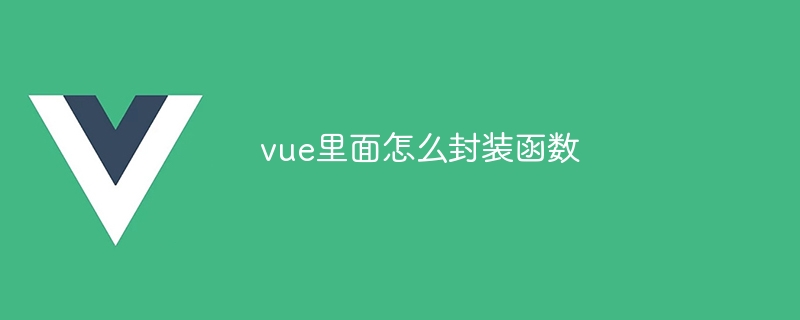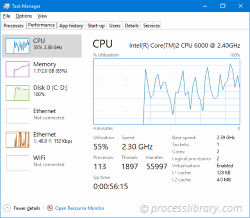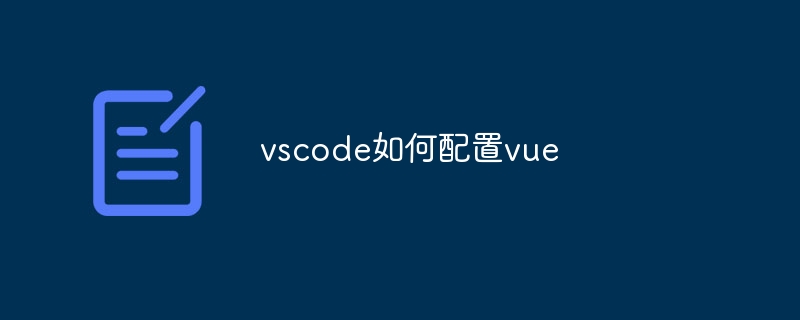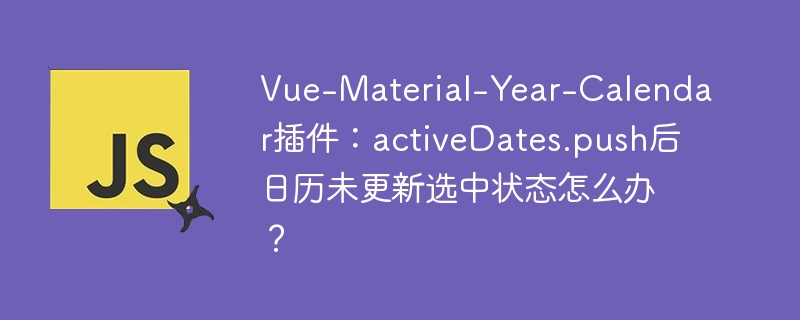Found a total of 10000 related content

How to encapsulate functions in vue
Article Introduction:There are three ways to encapsulate functions in Vue: 1. Use mixins to define functions in mixin files and use mixin options in components; 2. Use plug-ins to add functions to Vue prototypes and install plug-ins through install methods; 3. Use global methods to add functions to Vue prototypes through plug-ins. The selection method depends on project requirements and preferences.
2025-04-08
comment 0
834

What are custom plugins in Vue?
Article Introduction:To create a Vue custom plug-in, follow the following steps: 1. Define the plug-in object containing the install method; 2. Extend Vue by adding global methods, instance methods, directives, mixing or registering components in install; 3. Export the plug-in for importing and use elsewhere; 4. Register the plug-in through Vue.use (YourPlugin) in the main application file. For example, you can create a plugin that adds the $formatCurrency method for all components, and set Vue.prototype.$formatCurrency in install. When using plug-ins, be careful to avoid excessive pollution of global namespace, reduce side effects, and ensure that each plug-in is
2025-06-26
comment 0
914

divxplayeratiplugin.dll - What is divxplayeratiplugin.dll?
Article Introduction:What is divxplayeratiplugin.dll doing on my computer?
DivX Player 2.x Plug-In for ATI Remote Wonder. This process is still being reviewed.
Non-system processes like divxplayeratiplugin.dll originate from software you installed on your system. S
2024-11-02
comment 0
949

How to configure vue with vscode
Article Introduction:How to configure VSCode to write Vue: Install the Vue CLI and VSCode Vue plug-in. Create a Vue project. Set syntax highlighting, linting, automatic formatting, and code snippets. Install ESLint and Prettier to enhance code quality. Integrated Git (optional). After the configuration is complete, VSCode is ready for Vue development.
2025-04-16
comment 0
792

How to open a video with xml
Article Introduction:XML itself cannot open the video directly, so you need to use the following method: use the player plug-in to parse the video URL and play the video. Use the video embed code to embed the video into an XML file to play.
2025-04-03
comment 0
1158

How to create and use a Vue plugin?
Article Introduction:How to create and use Vue plugin? The Vue plugin is an object with the install method to add global functionality to the entire application. 1. The basic structure of the plug-in is to define an object containing the install method, which receives app and options parameters; 2. In the install method, you can add global methods, register components or instructions, inject mixed in, etc.; 3. Use app.use() to register the plug-in and pass in options; 4. Get plug-in methods through this.$method or Composition API in the component; 5. It is recommended to keep a single responsibility, support configuration parameters, avoid naming conflicts, and improve compatibility with Composition API; 6
2025-07-10
comment 0
283

How to interface with the backend with vue
Article Introduction:Vue interacts with the backend API to follow the following steps: 1. Install the Axios plug-in; 2. Introduce Axios; 3. Use Axios to initiate HTTP requests; 4. Handle server responses.
2025-04-08
comment 0
608

4 Simple Ways to Add Audio to Your WordPress Site
Article Introduction:Easily add audio files on your WordPress website without any coding knowledge! This article will guide you how to use WordPress built-in features and plug-ins to easily add audio content and improve user experience.
Key points:
WordPress supports audio files by default, adding audio is as simple as adding pictures.
WordPress comes with audio player that supports MP3, M4A, OGG and WAV formats, and can create playlists.
You can use external audio hosting platforms such as SoundCloud to embed audio to reduce the burden on the server.
For more features or customization options, use Compact WP Audio Player, MP3-jPlaye
2025-02-10
comment 0
705

How to use external libraries with Vue?
Article Introduction:There are four main ways to use external libraries in Vue projects: First, it is installed and modularly introduced through npm, suitable for libraries that support ES modules, which can be loaded on demand to reduce volume; second, it is registered as a Vue plug-in, suitable for libraries designed specifically for Vue such as VueRouter; third, it is introduced through CDN, which is not recommended but is suitable for rapid testing; fourth, it is global mount, which is easy to access multiple components but has the risk of pollution.
2025-06-26
comment 0
474



10 Best jQuery and HTML5 Media Players
Article Introduction:Ten best jQuery and HTML5 video players tutorials
In the past, Flash videos were used on websites because Flash was almost the only option to play videos. But now everyone wants video playback support to be broader, with multiple audio and video formats, playlists, adjustable controls, automatic aspect ratio video and more… All of these features can be achieved by using jQuery plug-in and HTML5, and you can use audio and video in a simple way. Check out the ten best jQuery and HTML5 player tutorials we have compiled below! enjoy! Related articles:
10 Crazy HTML5 and JS Experiments Showcase
jQuery and the new HTML5 key points
jQuery
2025-02-27
comment 0
554

How to analyze Vue build bundle size?
Article Introduction:Key methods for analyzing the volume of packages after Vue build include: 1. Use VueCLI built-in analysis function to generate visual reports; 2. Install and configure the webpack-bundle-analyzer plug-in to view the module volume ratio; 3. Check the size of vendor.js and app.js files in the dist directory to judge the volume distribution; 4. Use npmmls, yarnlist or source-map-explorer to analyze the dependency tree and specific file contents to find out the redundant introduction and optimization space.
2025-07-17
comment 0
968

How to create a custom Vue build?
Article Introduction:To create a custom Vue build version, first prepare the development environment, including installing Node.js, npm and cloning the official repository; secondly, modify the source code in the src directory according to the needs, such as deleting modules or adding instructions; then configure the build options in scripts/config.js, use Rollup to package and add terser compression and other plug-ins; finally execute npmrunbuild build and publish it to a private CDN or npmregistry. 1. Prepare the development environment: install Node.js and npm, clone the official Vue repository and install the dependencies. 2. Modify the source code: adjust the core logic, add and delete modules or add built-in instructions in the src directory. 3. Configure the build output: Edit c
2025-07-15
comment 0
163

HTML5 Video and Audio: The Markup - SitePoint
Article Introduction:Detailed explanation of HTML5 video and audio tags: Building a responsive video player
This article is excerpted from the book "HTML5 & CSS3 for the Real World, 2nd Edition" co-authored by Alexis Goldstein, Louis Lazaris and Estelle Weyl. This book is available in major bookstores around the world, and you can also purchase the e-book version here.
Core points
HTML5's video and audio tags allow for embedded video and audio elements directly in HTML code, without the need for external plug-ins or players.
HTML5 video and audio tags contain multiple attributes to control the behavior of these elements, such as autoplay
2025-02-18
comment 0
355

How to optimize CSS delivery in a Vue app?
Article Introduction:Methods to optimize CSS transmission in Vue applications include: 1. Loading styles on demand, and automatically importing and on-demand injection through component-level scoped styles and tools such as unplugin-vue-components to reduce global pollution and first-screen volume; 2. Enable on-demand introduction plug-ins, such as unplugin-element-plus, to only package the used component styles; 3. Inline the critical CSS into HTML, extract and insert critical path styles with the help of building tools to avoid additional request delays; 4. Load non-critical CSS asynchronously, use media attribute switching, dynamically create link tags or lazy loading library LoadCSS, and preload the corresponding styles in the route guard;
2025-07-17
comment 0
430

How to migrate from Vue 2 to Vue 3?
Article Introduction:When migrating Vue2 projects to Vue3, you need to pay attention to syntax differences, third-party plug-in compatibility and building tool selection. 1. Use VueCLI or Vite to upgrade the environment and ensure that Node.js version is above 14.x; 2. Note that Vue3 removes $on, $off, and $once, and the filter is replaced with calculation attributes or methods. The responsive system uses Proxy, and v-model binds modelValue by default; 3. Check whether third-party plug-ins support Vue3, and replace it with community fork or alternatives such as Pinia and VueRouterv4 if necessary; 4. Components can be gradually replaced through the vue-compat package to finally unify the code style.
2025-07-05
comment 0
416

How to use Pinia for state management?
Article Introduction:Pinia is a recommended state management library for Vue3. It is lighter, type-friendly and has clear structure than Vuex. 1. Use defineStore to create a store to manage independent state module; 2. Import and directly use the store's state and methods in the component, without .value or repeated import; 3. Multiple stores can be called to each other to achieve data sharing, improving maintenance; 4. Status persistence is achieved through the pinia-plugin-persistedstate plug-in, and refresh is not lost. It simplifies global state management and is suitable for most Vue project requirements.
2025-07-07
comment 0
748

















